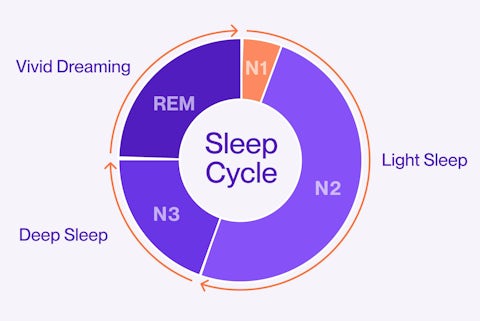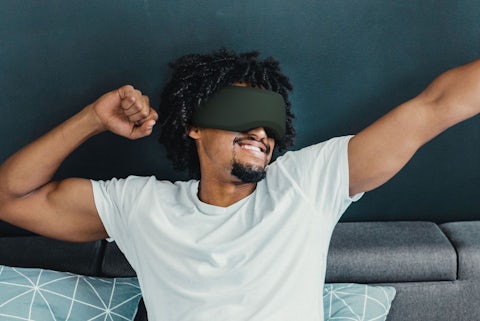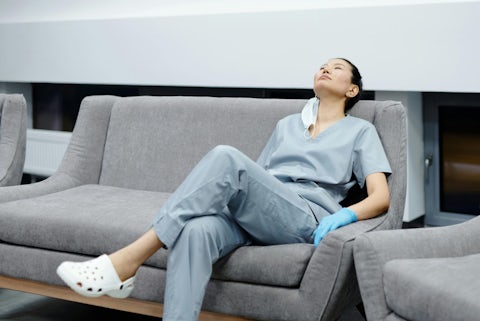How to Sleep on a Plane - 15 Tips for Long Flights
 Andrew Jolie March 12, 2024 8 min read
Andrew Jolie March 12, 2024 8 min read
Are you one of those people who cannot sleep on a plane no matter how hard you try?
For many travelers, flying can be a fun experience, taking us to far-off places within just a few hours and meeting nice strangers on the plane (sometimes nice). But one of the many challenges is getting enough sleep on long flights. The cramped seats, changes in cabin pressure and temperature, chatty Kathys, crying babies, and the constant and overbearing hum of the engines can make it challenging to find any decent type of shuteye.
If you're skimping on sleep during a flight, you might notice you're not quite yourself. Your brain might feel foggy, making focusing or remembering the little details tough. You could also find yourself getting snappy or moody. It may also cause you to feel exhausted and throw your coordination off.
And, you know, it's easier to catch a cold or something when you're not getting enough shut-eye. But hey, it's all temporary – catching up on sleep can get you back on track. Just goes to show, even when we're hopping time zones, trying to keep to some sort of sleep routine can really help.
So, how can you sleep on a long flight? Fortunately, with a few strategies and adjustments, you can improve your flight experience and get to your destination refreshed.
Best Tips for Sleeping on a Plane
Getting restful sleep on an airplane is possible with the right strategies. This article will share practical tips to enhance your comfort and relaxation, even in the cramped quarters of an airplane cabin. From choosing the best seat to essential items that can make a difference, these suggestions aim to help you feel refreshed and well-rested at your destination.
Pre-Flight Quick Tips
Pick a Good Seat
Your choice of seat can significantly impact your ability to sleep. Opt for a window seat, as it allows you to lean against the side of the plane for support and gives you control over the window shade. If you’re one of those people with a weak bladder and run to the toilet more often than not, this might not be the best option. Also, consider paying a little extra for seats with additional legroom or seats in a quieter area of the plane.
Dress for ZZZ’s
Wear loose, breathable clothing and layers to adjust to fluctuating temperatures onboard easily. Comfortable shoes or socks can also significantly affect how well you rest.
Time Zone Prep
Make sure you adapt your sleep schedule ahead of time when crossing time zones. Try to go to bed and wake up an hour earlier or later every day about three or four days before the flight to align closer with your destination's time zone.
Go Outdoors
Get outside before the flight for a brisk walk in fresh air if you can. Aside from the other tips here, this can work wonders to be able to fall asleep and sleep more soundly.
What to do Once on Board
Screen Time Timeouts
Did you know that blue light from screens can interfere with your body's ability to produce melatonin, the hormone that regulates sleep? If you’d rather sleep, you might want to avoid watching movies or using your iPad or smartphone an hour before sleeping. Listen to calming music or maybe read a good book.
Comfortable Aids
A neck pillow can help prevent your head from falling into uncomfortable positions, and a blanket will keep you warm in cool cabin temperatures. Investing in a high-quality, travel-friendly pillow and compact blanket can be a game-changer, although most airlines provide you with a free blanket and pillow. Admittedly, airplane pillows cannot compare to a good neck pillow. Make sure you invest in a sturdy one that supports your neck properly.
Distraction Blockers
Noise-canceling headphones or earplugs can help drown out the engine noise and that chatty Kathy or chatty Chad. A sleep mask can block out cabin light and any external light sources, creating an ideal environment for sleep. If you often have long flights, consider investing in cutting-edge technology sleep masks that block out light and use neurofeedback/neural music for deep sleep and relaxation like a Bia Sleep Mask.
Hydration Balance
Drinking water is crucial, as the cabin air is very dry, but limit your intake before sleeping to avoid frequent bathroom trips. Avoid drinking alcohol and caffeine. They can disrupt your sleep cycle. People seem to think that alcohol will make them sleep better and while it may knock you out, you won’t feel refreshed when you wake up. It sort of defeats the purpose. And, you want to make sure you’re not taking any sleeping meds with alcohol, for obvious reasons.
Get that Window Seat!
While the limited space can be challenging, try to find a comfortable position that works for you. If you're in a window seat, leaning against the wall with a pillow for cushioning, not to mention comfort, can be highly effective. Reclining your seat slightly (obviously, while being considerate of the person behind you) and using a pillow for lower back support can help those in an aisle or middle seat.
Chill Techniques
Exercises like deep breathing, meditation, or progressive muscle relaxation to keep your body relaxed and tune you in for sleep. Apps that offer guided meditation or soothing sounds can be handy. Or, as mentioned above, invest in a high-tech sleep mask that provides all of that.
Stay Warm
Airlines often provide blankets, but having an extra layer, like an oversized scarf or a lightweight travel blanket, keeps you warm and comfortable throughout the flight. Consider getting some flight socks as they keep your feet a bit warmer than regular ones. Use some compression stockings to prevent cramps if you’re prone to that.
Don’t Pig Out
Eating a whopper of a meal before trying to sleep can cause bloating and indigestion. Not to mention the nice little “side-effect” (dare we mention cheese?) that goes along with it. Opt for a light meal or snack instead. Eat according to the meal times of your destination, if you can, to help adjust your body clock.
Use Meds Wisely
While over-the-counter sleep aids or prescription medications can help some travelers, they're not suitable for everyone. Consult with your healthcare provider before your flight to discuss your best approach. Consider taking natural supplements like melatonin, but discussing this with your doctor is also necessary.
Good Sleep Hygiene
Even in the air, the principles of good sleep hygiene apply. Try to keep to a routine similar to what you'd do at home before bed, such as brushing your teeth, getting in some light reading or listening to music. Nobody likes waking up to breath that smells like smelly socks.
Upgrade Those Seats
For extremely long flights, if your budget allows, upgrading to premium economy, business, or first class can provide more comfort and space to sleep. The flat-bed seats in business and first class can significantly enhance your ability to sleep if you can afford it.
Airplane Sleeping Hack
The Bía Smart Sleep Mask mentioned in the article is an ideal travel companion for frequent flyers looking for restful sleep on airplanes. Its cutting-edge design incorporates neural music and neurofeedback technology to induce relaxation and sleep in the challenging air travel environment. By blocking out cabin noise and light, the mask helps your body tune into a state of relaxation, allowing for a swift transition into sleep.
The neurofeedback feature adjusts in real-time to your sleep stages, ensuring that even in the cramped quarters of an airplane, you can achieve deep, restorative sleep. The mask's ability to simulate sunrise offers a gentle and natural way to wake up, making jet lag less daunting by syncing your body's clock to your destination's time zone. Whether it's a short hop or a long-haul flight, the Bía Smart Sleep Mask can significantly improve sleep quality, making you feel refreshed and energized at your destination.
Frequently Asked Questions
How do you sleep on an overnight flight in economy?
Focus on creating a comfortable, distraction-free environment. Use a neck pillow, blanket, earplugs, and an eye mask to mimic a quiet, dark bedroom as much as possible.
What is the best way to sleep on a long-haul flight?
Choose a window seat for support, limit screen time before sleeping, stay hydrated, and use relaxation techniques to ease into sleep. Buckle up as long as you’re seated so the flight attendant doesn’t have to wake you up and instruct you to put it on during turbulence. Also, don’t cross your legs. This may stop your blood-flow and make for uncomfortable sleep.
How can I maximize my sleep on a plane?
Create a conducive sleep environment with a neck pillow, earplugs, and eye mask. A really cool gadget is the Bia Sleep Mask that not only blocks out light and cover your ears, it also plays neural music to soothe your mind and help you relax. Adjust your meal and sleep times to match your destination's time zone as closely as possible.
Can you really sleep comfortably on an overnight flight?
Yes, with the right tools and strategies, such as selecting an optimal seat, using sleep aids appropriately, and practicing relaxation techniques, you can improve your chances of sleeping comfortably.
Sleeping on a plane doesn't have to be impossible. Using some of these tips, from seat selection and packing essentials to relaxation techniques and dietary tips, you can improve your ability to sleep on long flights. By planning and making a few adjustments, you'll be in a better position to get to where you're going feeling rested and ready to enjoy your trip.


